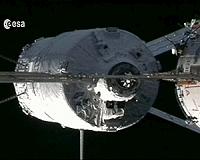 |
Washington (AFP) Feb 26, 2011 The US space shuttle Discovery docked with the International Space Station on Saturday for a final time before it retires, carrying a new module and a robot to the orbiting research lab. NASA's oldest and most heavily traveled shuttle linked up with the ISS at 2:14 pm (1914 GMT) as the space outpost was 220 miles (350 kilometers) over western Australia, mission control in Houston said. Discovery arrived in spectacular fashion, with Commander Steve Lindsey executing a "rendezvous pitch maneuver," a one-degree-per-second rotational backflip, before docking. The ISS is a crowded place these days, with space vehicles and labs from every nation involved in the international research station currently docked there. "This is the first time all visiting vehicles have something represented," mission control in Houston said, noting that the mass of the floating ISS is now a whopping 1.2 million pounds (540,000 kilograms). Japan's HTV vehicle, Russia's Progress and Soyuz craft, the Canadian Dexter robot and the European ATV-2 supply ship are all there, NASA said. The shuttle's arrival caused a rocking the boat motion on the orbiting lab, and it took about 45 minutes for the waves to stop. "A hard mate between Discovery and the station was delayed to 3:04 pm ET (2004 GMT) while relative motions between the spacecraft dampened out," NASA said in Twitter message. The arrival of the US crew brings the total staff on board the ISS to 12. Three Russians, one Italian and two Americans, including commander Scott Kelly, were already at the station when Discovery arrived. Kelly's twin brother Mark is also an astronaut and is scheduled to fly on the US shuttle Endeavour toward the ISS in April. Discovery launched on Thursday from Kennedy Space Center in Florida, carrying an all-American crew of six astronauts. The liftoff drew thousands of onlookers eager to catch a glimpse of one of the last three shuttle launches. The space shuttle program will end later this year, after Endeavour launches in April followed by Atlantis in June, leaving Russia's space capsules as the sole method of transport for astronauts heading to the ISS. The Discovery crew is there to deliver the Permanent Multipurpose Module, with extra storage space and an area for experiments, as well as some spare parts and the Express Logistic Carrier, an external platform for large equipment. The shuttle has also brought the first humanoid robot to the ISS. The Robonaut 2, or R2, is a joint project of General Motors and NASA and will stay behind as a permanent resident of the space station when the shuttle leaves. When Discovery wraps up its tour, the oldest surviving shuttle will have flown more missions than any of its cohorts and transported 180 people into space. Since its first launch in 1984, Discovery transported the Hubble Space telescope, was the first to rendezvous with the Russian Mir Space Station, and delivered part of the Japanese Kibo lab to the ISS. Discovery has circled the globe more than 5,600 times and logged 142 million miles (230 million kilometers) over its 352 days in space leading up to the present mission. The end of the shuttle program will create a gaping hole in the US space program during a period of belt-tightening and budget freezes. It may be a decade before the American space program can create a new heavy lift rocket and crew capsule to bring astronauts to space again, NASA's chief technologist said.
Share This Article With Planet Earth
Related Links Station at NASA Station and More at Roscosmos S.P. Korolev RSC Energia Watch NASA TV via Space.TV Space Station News at Space-Travel.Com
 Europe's ATV Supply Ship Docks Safely With ISS
Europe's ATV Supply Ship Docks Safely With ISSParis, France (ESA) Feb 25, 2011 Eight days after launch, ESA's latest Automated Transfer Vehicle, Johannes Kepler, completed a flawless rendezvous and docking with the International Space Station at 17:08 CET (16:08 GMT) to deliver essential supplies. The approach and docking were achieved autonomously by its own computers, closely monitored by ESA and French space agency (CNES) teams at the ATV Control Centre in Toulous ... read more |
|
| The content herein, unless otherwise known to be public domain, are Copyright 1995-2010 - SpaceDaily. AFP and UPI Wire Stories are copyright Agence France-Presse and United Press International. ESA Portal Reports are copyright European Space Agency. All NASA sourced material is public domain. Additional copyrights may apply in whole or part to other bona fide parties. Advertising does not imply endorsement,agreement or approval of any opinions, statements or information provided by SpaceDaily on any Web page published or hosted by SpaceDaily. Privacy Statement |